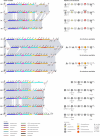Genetic analysis of the capsular biosynthetic locus from all 90 pneumococcal serotypes
- PMID: 16532061
- PMCID: PMC1391919
- DOI: 10.1371/journal.pgen.0020031
Genetic analysis of the capsular biosynthetic locus from all 90 pneumococcal serotypes
Abstract
Several major invasive bacterial pathogens are encapsulated. Expression of a polysaccharide capsule is essential for survival in the blood, and thus for virulence, but also is a target for host antibodies and the basis for effective vaccines. Encapsulated species typically exhibit antigenic variation and express one of a number of immunochemically distinct capsular polysaccharides that define serotypes. We provide the sequences of the capsular biosynthetic genes of all 90 serotypes of Streptococcus pneumoniae and relate these to the known polysaccharide structures and patterns of immunological reactivity of typing sera, thereby providing the most complete understanding of the genetics and origins of bacterial polysaccharide diversity, laying the foundations for molecular serotyping. This is the first time, to our knowledge, that a complete repertoire of capsular biosynthetic genes has been available, enabling a holistic analysis of a bacterial polysaccharide biosynthesis system. Remarkably, the total size of alternative coding DNA at this one locus exceeds 1.8 Mbp, almost equivalent to the entire S. pneumoniae chromosomal complement.
Conflict of interest statement
Competing interests. The authors have declared that no competing interests exist.
Figures


References
-
- Austrian R. The pneumococcus at the millennium: Not down, not out. J Infect Dis. 1999;179(Suppl 2):S338–S341. - PubMed
-
- Cartwright K. Pneumococcal disease in Western Europe: Burden of disease, antibiotic resistance and management. Eur J Pediatr. 2002;161:188–195. - PubMed
-
- Lund E, Henrichsen J. Laboratory diagnosis, serology and epidemiology of Streptococcus pneumoniae . In: Bergan T, Norris J, editors. Methods in microbiology. London: Academic Press; 1978. pp. 241–262.
-
- Hausdorff WP, Bryant J, Paradiso PR, Siber GR. Which pneumococcal serogroups cause the most invasive disease: Implications for conjugate vaccine formulation and use, part I. Clin Infect Dis. 2000;30:100–121. - PubMed
Publication types
MeSH terms
Substances
Grants and funding
LinkOut - more resources
Full Text Sources
Other Literature Sources
Molecular Biology Databases
Miscellaneous

